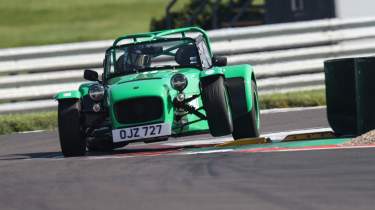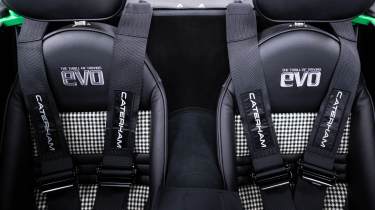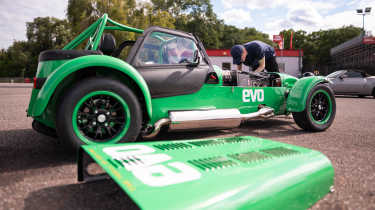Caterham Seven evo25 Fast Fleet test – living with a track car for the road
Our Seven has been spreading sports car joy to anyone and everyone within its orbit
The sports car enjoys an image in some quarters as a lone-ranger, borderline-selfish creation, to be enjoyed by the driver and the driver alone. In reality, though, I think sports cars are at their best when they’re shared experiences.
The evo Caterham is a good case study for this theory. It’s been a bonding agent for friends, neighbours, and complete strangers. Anyone and everyone wants to chat whenever I stop in a car park or at a petrol station. Closer to home, while I’ve been playing the game of bike-and-lawnmower Tetris that’s involved in getting the Caterham into, or extricating it from, my garage, neighbours have popped over for brief chats, which have turned into longer conversations and, inexorably, passenger rides in the Seven.
> Mazda MX-5 2.0 Fast Fleet test – 12 months in the featherweight roadster
They’ve all been as captivated by it as I am. There’s something experientially extra-special about an open-air, minimalist sports car. Colin Chapman’s description of the Lotus Seven as motorcycling on four wheels is about as good a way of putting it as I can think of, and the Seven as a 3D object to pore over is enchanting like a motorcycle, too. The evo edition spec, with its Signal Green paint (plus colour-coded wheels and roll-cage) and houndstooth seats, has gone down well. That finish, together with the evo emblem embroidered into the headrests, is a part of Caterham’s ‘Signature’ customisation range, so although it’s nice to think that Seven customers might choose the evo logo for their own cars, in reality they can spec more or less any design they fancy, within reason.
More reviews
Group tests
- Ariel Atom 4R v Caterham Seven ‘evo25’: power-to-weight heroes go head-to-head
- Caterham Super Seven 600 v Super Seven 2000
Long term tests
Reviews
Those seats have proved genuinely comfy on longer trips, supporting me in all the right places, although everyone is a different size and shape and others find them harder work. We’ve got the track harnesses in our car, and though they take longer to do up than an over-the-shoulder belt, I feel much safer with four points clicked into place in a car like this than I do with an inertia-reel belt. Not because the Caterham itself feels dicey; it’s more other cars that can make you feel vulnerable, particularly given the hulking size of most modern traffic. (I’m particularly wary of disappearing in other cars’ blind spots on dual carriageways.) Once you’re harnessed into place, the seats feel almost as supportive as the track-spec buckets that normally come with R-spec Sevens.
There’s something about climbing into the Seven, belting up and firing the engine that puts me in mind of flying a light aircraft; the pre-flight checks, and the sound and vibration of the 2-litre engine twisting into life like that of a prop plane. Plus you need to wear a headset, or earplugs at least, to make road noise tolerable on the motorway.
Its ride quality can be weightless, too, thanks to the adjustable dampers that are part of the evo25’s spec. Developed by Caterham together with Bilstein, they’re normally fitted only to the track-focused 420 Cup model but they’re an equally valuable asset on the road. There’s a bigger difference between each of the clicks in the softest settings (1-5) than the firmest (6-10), and setting all of the dampers to 3 or below creates a true magic-carpet ride. Less than that is even more cushioned but can lead to the car occasionally grounding out in big compressions. Three out of ten all round feels about the sweet spot for most roads, or four if you know you’re not going to encounter any big bumps. Being able to adjust them so easily with just a quick turn by hand at each corner – and play with the balance front to rear without unduly upsetting the handling, too – adds a whole new dimension to the car.
That’s true of the 420 Cup, too, but that model’s straight-cut sequential gearbox is simply too much hard work on the road. The evo25’s snickety five-speed H-pattern is far more manageable – and quieter – and the car is still fast and fantastic fun on track too, as we’ve found at Brands Hatch and Goodwood.
Out on the public road, slightly off-puttingly, at night the dashboard switches illuminate with blue backlight, which reflects in the doors’ plastic windows and occasionally makes me think I’m being pursued by blue flashing lights. The chances of being caught speeding in the Seven are thankfully slim because it’s so much fun at speeds well below the limit, so you rarely feel the need to fully let it off the leash.
At all speeds, there’s something quite zen about driving the Seven, whether solo or with friends, family or neighbours. The final verdict goes to my neighbour’s ten-year-old daughter: ‘It’s the funnest car ever.’ Only Colin Chapman could put it better.
| Total mileage | 1638 |
| Mileage this month | 277 |
| Costs this month | £0 |
| mpg this month | 21.2 |
This story was first featured in evo issue 316.





